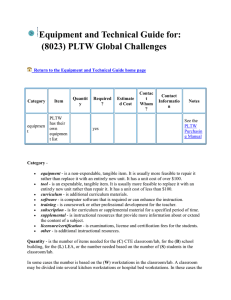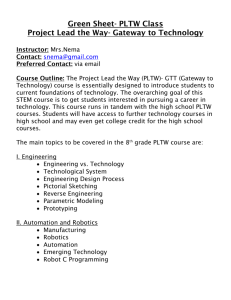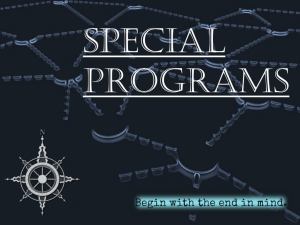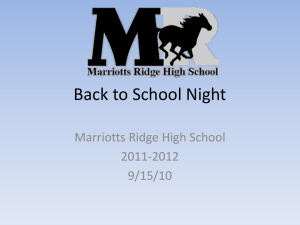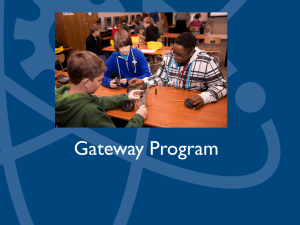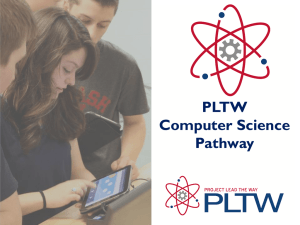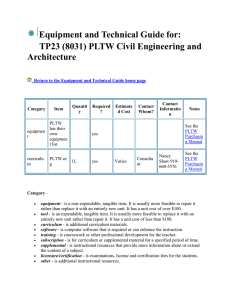PLTW 101
advertisement
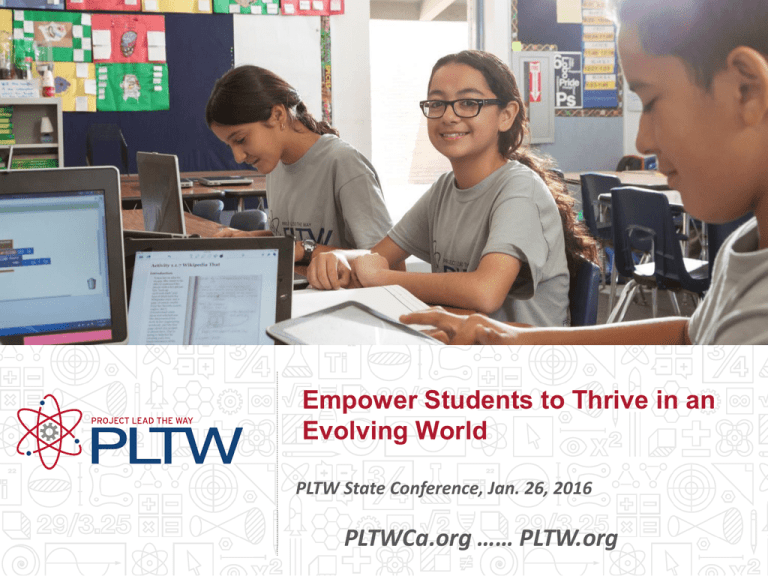
Empower Students to Thrive in an Evolving World PLTW State Conference, Jan. 26, 2016 PLTWCa.org …… PLTW.org About Project Lead The Way World-Class Curriculum High-Quality Professional Development Engaged Network Overview 8,000 schools More than 840 schools in California alone more than13,000 PLTW teachers trained more than 54 university affiliates 6 in California 700,000 students take a PLTW course every day with100s of partners More than PLTW Programs Launch Gateway Offered in ten-hour modules, engages students in analysis, collaboration, creative thinking, and problem solving as they explore a wide range of topics. Offered in nineweek units, inspires critical thinking to explore STEM careers through topics such as energy, robotics, healthcare, and architecture. Biomedical Science Computer Science Offered in full-year Offered in full- and courses, investigates half-year courses, biomedical careers develops through concepts such computational thinking as human medicine, skills and through physiology, genetics, concepts including microbiology, and coding, data mining, public health. big data, and cybersecurity. Engineering Offered in full-year courses, explores the engineering design process by linking STEM principles to real-world problem solving in various engineering fields. Making a Difference in Students’ Lives PLTW contributes to a strong, positive impact on mathematics and science achievement and offers a pathway to prepare and motivate students to enter careers in science and engineering. Recent studies have shown: High school graduates who participated in PLTW were nearly three times as likely to major in STEM, and 3 to 4 times more likely to study engineering, versus nonPLTW graduates. PLTW students are more prepared for and attended higher education institutions at a higher rate and scored higher on the state’s mathematics assessment. Many engineering universities report high and increasing levels of PLTW student enrollment. More research about PLTW: pltw.org/about-us/our-impact PLTW Alumni Data Milwaukee School of Engineering 121 former PLTW students 90% Retention (first year) Average PLTW GPA is 0.18 higher Oklahoma State University 101 former PLTW students 81.5% Retention (in engineering) 12.3% Transferred (out of engineering) Activities, Projects, and Problems PLTW® AP2 Modality Activities are written and designed to provide students the experience needed to acquire the skills they will use throughout a course. Projects are written and designed to aid students in developing and beginning to apply critical thinking skills and knowledge. Problems are written and designed to utilize all skills and knowledge acquired through activities and projects in an openended format that aids students in developing full understanding of the main concepts and principles of the course. Project-based learning gives students: • Hands-on, rigorous, relevant, real-world experiences • The chance to use scientific sensors, VEX & ROBOTC, industry software (Revit, Inventor) • Opportunities to be creative and solve problems • The realization that there isn’t just one right answer What Students do Well in PLTW? Students who: • Show interest in STEM (Science, Technology, Engineering, or Math) career fields. • Are creative – Like art and design. • Enjoy working with computers. • Learn best in “hands-on” classes. • Are in the upper 80% of their class. Launch video Early Access Matters percent of scientists and graduate students in a 2010 study stated that their interest in science began before middle school. PLTW Launch • Kindergarten • • • • Structure & Function: Exploring Design Pushes and Pulls Structure & Function: Human Body Animals & Algorithms • First Grade • • • • Light and Sound Light: Observing the Sun, Moon, and Stars Animal Adaptations Animated Storytelling • Second Grade • • • • Materials Science: Properties of Matter Materials & Science: Form & Function The Changing Earth Grids & Games • Third Grade • • • • Stability & Motion: Science of Flight Stability & Motion: Forces & Interactions Variation of Traits Programming Patterns • Fourth Grade • • • • Energy: Collisions Energy: Conversion Input/Output: Computer Systems Input/Output: Human Brain • Fifth Grade • • • • Robotics & Automation Robotics & Automation: Challenge Infection: Detection Infection: Modeling & Simulation World-Class Curriculum • Activity, project, problem-based • Aligned to Common Core and NGSS • Allows for flexibility and customization – Designed for Kindergarten to 5th grade – Four modules per grade. Each module is ~10 hours. • First module of each grade focuses on the design process • Integrates formative and summative assessments PLTW Design Pathway Design Process for Every Age Design Process K-5 What it looks like & means K-2 What it looks like & means 3-5 Ask Students ask questions, make observations and gather information to define a simple problem. Students define a simple design problem including specified criteria and constraints. Explore Students develop simple drawings to generate ideas of how to solve the given problem. Students generate and compare multiple possible solutions. Model Students develop a simple sketch to illustrate how the chosen concept will function to solve the given problem and develop a simple physical model. Students develop a solution to a problem based on how well each is likely to meet the criteria and constraints of the problem and construct a prototype. Evaluate Students analyze data from tests of two objects and compare strengths and weaknesses of how each performs. Students plan and carry out fair tests in which variables are controlled. Students consider failure points of data collected to identify aspects of the design solution that can be improved. Explain Students reflect on their design solution including one or two suggestions for improvement. Students communicate their design solution including specific suggestions for improvement. Launch Modules (first two of four per grade) Module Titles Aligned to Grade Structure and Function Kindergarten Pushes and Pulls Kindergarten Waves: Light and Sound 1st grade Observing the Earth, Sun, Moon, and Stars 1st grade Matter and Materials Science 2nd grade Engineering Design: Dispersing Seeds 2nd grade Motion and Stability: Science of Flight 3rd grade Motion and Stability: Forces and Interactions 3rd grade Energy: Collisions 4th grade Energy: Conversion 4th grade Robotics: The Power of Automation 5th grade Robotics: Challenge 5th grade Paintbrush Design Activity Aligned to Kindergarten standards Scalable, school-wide model for elementary core training Trainers PLTW Master Teachers Lead Teachers PLTW three-phased approach fully supports elementary STEM teachers: Readiness Training – On-demand and live-online – Focus on core knowledge/skill Core Training – 3 days in-person training for the program – Focus on pedagogy and activity, project, problem-based learning Ongoing Training – On-demand and live online by module – Focus on pedagogical-content knowledge by module PLTW Teachers Gateway To Technology units 9 week units designed for grades 6-8 Foundation Units Design & Modeling Automation & Robotics Specialized Units Medical Detectives Flight & Space Science of Technology Energy and the Environment Green Architecture Magic of Electrons Intro to Computer Science Gateway foundation units • Design & Modeling – Apply design process to solve problems – Work in teams to design a hobby organizer, furniture, new playground – Use Autodesk® design software to create virtual image of designs and produce a portfolio of solutions • Automation & Robotics – Learn about mechanical systems, energy transfer, machine automation, and computer control systems – Use the VEX Robotics® platform to design, build, and program real-world objects Gateway specialization units • Energy and the Environment – Design and model alternative energy sources and evaluate options for reducing energy consumption through energy efficiency and sustainability • Flight and Space – Explore the science behind aeronautics; design, build, and test an airfoil • Green Architecture – Study dimensioning, measuring, and architectural sustainability; design affordable housing units using Autodesk’s® 3D architectural design software • Magic of Electrons – Delve into electricity, the behavior and parts of atoms, and sensing devices; learn knowledge and skills in basic circuitry design and examine the impact of electricity • Medical Detectives – Analyze genetic testing results to diagnose disease and study DNA evidence found at a “crime scene”; learn how to measure and interpret vital signs and diagnose diseases • Science of Technology – Apply concepts of physics, chemistry, and nanotechnology to activities and projects including making ice cream, cleaning up an oil spill, and designing, building, and testing a new product • Introduction to Computer Science – Designed to be the first computer science course for students who have never programmed before, ICS is an optional starting point for the PLTW Computer Science program. Gateway grows student interest in PLTW’s advanced programs and STEM careers Gateway To Technology Unit Pathway To Engineering and Biomedical Sciences PLTW Courses Automation and Robotics Principles of Engineering Computer Integrated Manufacturing Computer Science/Software Engineering Design and Modeling Introduction to Engineering Design Energy and the Environment Biotechnical Engineering Principles of Engineering Flight and Space Aerospace Engineering Green Architecture Civil Engineering and Architecture Medical Detectives Principles of the Biomedical Sciences Human Body Systems Medical Interventions Biomedical Innovation Magic of Electrons Digital Electronics Science of Technology Biotechnical Engineering Introduction to Engineering Design Principles of Engineering Introduction to Computer Science (ICS, 0.5 year) Designed to be the first computer science course for students who have never programmed before, ICS is an optional starting point for the PLTW Computer Science program. Students create interactive stories in Scratch™ (an easy-to-use programming language); work in teams to create simple apps for mobile devices using App Inventor; and analyze data about students' health, social habits, and interests using functions in Excel®. Students will learn the impact of computing in society and the application of computing across career paths. They will also transfer the understanding of programming gained in App Inventor to a third language, Python®, in which they learn introductory elements of textbased programming. The course aligns with the Computer Science Teachers Association (CSTA) 3A standards. Training for the Gateway units Training for the Gateway units will be offered as one week or 3-day sessions. These will be: • AR – automation & robotics, one week • DM – design and modeling, one week • FS, ME, ST, GA, and EE are 3 days • MD, ICS one week Gateway Program Summary of Program Requirements • All Gateway courses are designed as 45 class periods that are approximately 45 minutes long. • Schools may offer courses from grade six through grade eight in a manner determined reasonable and appropriate for the school. Local schools will determine the PLTW sequence of units which they will implement to fulfill their agreements. PLTW Biomedical Science Full-Year Courses: • Principles of Biomedical Science • Human Body Systems • Medical Interventions • Biomedical Innovations Biomedical Sciences Program Summary of Program Requirements • Schools must offer the PLTW courses in sequence. – Flexible program • Students can begin the program in 9th, 10th or 11th grade. • Can take 1 course each year or double up and take 2 consecutive courses simultaneously. Biomedical Sciences Program Summary of Program Requirements • Schools must offer a minimum of three PLTW courses. • All PLTW courses require concurrent enrollment in college preparatory mathematics and science courses. • All PLTW courses are designed as year-long courses (45-50 minute schedule). – Block Schedule (90 min.): can be completed in a semester Course # 1: Principles of the Biomedical Sciences Study of human medicine, research processes and an introduction to bioinformatics. Investigate the human body systems and various health conditions including: heart disease, diabetes, sickle-cell disease, hypercholesterolemia, and infectious diseases. Course #2: Human Body Systems Students study basic human physiology, especially in relationship to human health. A central theme is how the body systems work together to maintain internal balance and good health. Students use data acquisition software to monitor body functions and use the Anatomy with Clay® Manikens™ to study body structure. Course #3: Medical Interventions Investigate various medical interventions that extend and improve the quality of life including: diagnostics, surgery, pharmacology, bio-nanotechnology, prosthetics, rehabilitation, and lifestyle choices. Course #4: Biomedical Innovation Capstone Course – Apply their knowledge and skills to solve problems related to the biomedical sciences Work with a mentor/advisor from a university, hospital, physician’s office, or industry as they complete their research and problem-solution process Present their findings and results in a symposium style format to an audience, consisting of representatives from the local healthcare or business community or the school’s PLTW partnership team Biomedical Innovation Problems: Design a more efficient emergency room. Design an experiment using sensors and data acquisition software to monitor or measure a physiological change. Design a medical intervention to aid patients. Evaluate water quality and propose solutions to eliminate contamination of water sources. Design a solution to a local or global public health challenge. Engineering Course Structure • Foundation • Introduction to Engineering Design • Principles of Engineering • • • • • Specialization Aerospace Engineering Biotechnical Engineering Civil Engineering & Architecture Computer Integrated Manufacturing Digital Electronics Computer Science Capstone Engineering Design & Development Introduction to Engineering Design Overview IED Units • Design Process • Technical Sketching and Drawing • Measurement and Statistics • Modeling Skills • Geometry of Design • Reverse Engineering • Documentation • Advanced Computer Modeling • Design Team • Design Challenges Introduction To Engineering Design Unit 1: Introduction to Design The design process Technical sketching and drawing Puzzle cube project Unit 2: Design Solutions Geometric shapes and solids Dimensions and tolerances Advanced 3D modeling skills and designs Principles of Engineering POE Units • Energy and Power • Materials and Structures • Control Systems • Statistics & Ballistics Solar Hydrogen System Truss Design Pneumatic Brake Design Self Propelled Vehicle Specialization Courses • Aerospace Engineering (AE) – Learn the fundamentals of atmospheric and space flight through projects such as designing an airfoil, propulsion system, rocket and glider • Environmental Sustainability (ES) – Engage in design problems related to clean water, food supply issues and renewable energy • Civil Engineering and Architecture (CEA) – Discover the design and construction industry while designing both residential and commercial projects using Autodesk® 3D-architectural design software • Computer Integrated Manufacturing (CIM) – Explore designing products for manufacturability, manufacturing processes, CNC machining, factory system modeling, automation, and robotics • Digital Electronics (DE) – Learn the fundamentals of combinational and sequential logic circuit design and create fully-functioning digital circuits • Computer Science & Software Engineering (CSE) – Also a foundation course in the new Computer Science pathway Environmental Sustainability • Biological Engineering for a Better Tomorrow • Ensuring Safe and Abundant Water • Food Security • Renewable Fuels Students investigate and design solutions in response to real‐world challenges related to clean and abundant drinking water, food supply issues, and renewable energy. Students research and design potential solutions to these true‐to‐life challenges Civil Engineering & Architecture CEA Units • Overview of Civil Engineering & Architecture • Residential Design • Commercial Applications • Commercial Building Systems Projects • Green Utility Shed • Keystone Library Renovation Capstone Course • Engineering Design and Development (EDD) – Research, design, and construct solutions to engineering problems • Components – Project Management – Researching a Problem – Designing a Solution – Creating a Prototype and Testing Plan – Evaluation and Reflection on the Design Process – Presentation of the Design Process – Going Beyond Engineering Design and Development Pathway to Engineering Program Summary of Program Requirements • Schools must offer a minimum of three PLTW courses over a three-year period. These three courses must include IED and POE and a minimum of one specialization and/or capstone course of the school’s choice. • All PLTW courses require concurrent enrollment in college preparatory mathematics. Concurrent enrollment in college preparatory science is strongly recommended. PLTW Computer Science Courses: • Introduction to Computer Science (0.5 year) • Computer Science and Software Engineering (1 year) • Computer Science Applications (1 year) • Simulation and Modeling (0.5 year) • Artificial Intelligence (0.5 year) • Cybersecurity (0.5 year) • Computational Problem Solving (1 year) Computer Science and Software Eng Unit 1. Graphics and GUIs Students work with Scratch and Python languages to solve a number of Graphics Problems Unit 2. The Web Students are introduced to HTML, CSS, JavaScript, SQL and PHP to learn about the Internet and the Web. Unit 3. Discovery in data and App Invention Students study large-scale data collection and analysis in a variety of applications. They create a mobile app that stores a large data set concerning themselves. Unit 4. Predicting, Understanding and Communicating with Simulation Students identify problems and questions that can be addressed with computer simulation, This final project is student directed and relevant to their own life. Pathway to Engineering – Foundations • Introduction to Engineering Design [g – Elective: Interdisciplinary; f – Visual Arts] • Principles of Engineering [g – Elective: Interdisciplinary] Pathway to Engineering Specialization & Capstone • Aerospace Engineering • • • • • [g – Elective: Interdisciplinary] Civil Engineering & Architecture [g – Elective: Interdisciplinary] Computer Integrated Manufacturing [g – Elective: Other] Computer Science & Software Engineering [g – Elective:Mathematics] Digital Electronics [g – Elective: Interdisciplinary] Engineering Design & Development [d – Lab Science: Interdisciplinary] Biomedical Science • Principles of Biomedical Sciences (PBS) [d – Lab Science] • Human Body Systems (HBS) [d – Lab Science] • Medical Interventions (MI) [d – Lab Science] • Biomedical Innovation (BI) [g – Elective: Lab Science] All AllPLTW PLTWCourses Coursesare are“A-G” “A-G”Approved Approved Future a-g efforts will focus on changing interdisciplinary electives to science electives so they can satisfy the new CSU entry option. Updates available at www.pltwca.org Or the UC “a-g doorways” portal; search under Project Lead The Way. PLTW Student Opportunity through STEM Premier • PLTW students can create a free profile and showcase their best work, brand themselves, and connect to colleges and companies based on their skills and interests. • Available at no cost to PLTW middle and high school students (ages 13 and older). • Students sign up through myPLTW.org. Common Core State Standards & Next Generation Science Standards Alignment •As of October 2012, all PLTW courses and units are aligned to Common Core State Standards for Mathematics and English Language Arts. •Alignments to Next Generation Science Standards (NGSS) are also available •Form to request alignments are available at https://www.pltw.org/alignment PLTW Professional Development Renowned Professional Development for Teachers Three phases: Readiness Training Core Training Ongoing Training Conducted in partnership with nearly 60 colleges and universities across the country. More than 6,000 teachers trained in 2014. 2016 Summer Core Training for CA The tentative training schedule is listed in the conference brochure Engineering, GTT, Launch: Cal Poly Pomona San Diego State University San Jose State University Chico State University BMS: Cal State East Bay University of San Diego Registration Process: Teachers will need to complete their online pre-training before being able to register. Reservations: If your school has an outstanding balance from a previous summer training, you will not be allowed to reserve a spot nor register at any of the Affiliates’ trainings. Refresher Workshops • • • • Fall and Spring workshops available Free to PLTW teachers Various regional workshops Visit Calendar/Events Page on pltwca.org Continue Your Learning March 20-23, 2016 Indianapolis, Indiana www.PLTW.org/PLTWSummit The Most Important Things you will Hear Today… • PLTW is an Elective and it is NOT “Magic”, • You must recruit students, especially girls. • You must have “kid-magnet” teachers. Versatile Implementation Models • Combine classes, one teacher in a block; – Teach IED and Geometry – Teach POE and Physics • Use at low-performing academies to grab the forgotten middle that sleeps through lecture. • School within a school. • Career Pathway in Linked Learning • Core classes in a CPA • Use as the core of a magnet academy Recruiting Techniques • Recruit a “rock star” teacher • Take PLTW students and projects to other classes. • Student demographics should match the ones you want to recruit • Recruit at the Middle Schools (esp. feeder schools) • Help the Middle Schools run the GTT program • Tell parents using PTA, local papers, and “Elective Fairs” • Start a Robotics Team or Tinkering Club • Work on making the courses girl-friendly; teach “Design” not “Pre- Engineering” School District Commitments • • • • • • • • • Implement PLTW curriculum Support teachers in Professional Development Counselors participate in conferences Provide teachers with specified equipment Form a teacher-led partnership team Participate in student evaluation of PLTW Commit to on-going training opportunities Interact with PLTW State Leader Option to become certified PLTW school Launch Costs Investment Area Program Participation Fee Professional Development Description Price Range Per school (per unique school NCES Code) $750 Lead Teacher Training & Certification $700 Additional Classroom Teachers, Training & Cert. General Supply Kits (Per class of 30 students, per module) $0 $200-350 Classroom Kits iPads VEX IQ Robotics Equipment (2-4 students/kit) Classroom set of 12 (iPad or iPad Minis) $120-365 $4200-4800 Cost to Schools Participation Fee - $3,000 PTE, $750 GTT, $2,000 BMS, $2,000 CSE, $750 Elem. • Teacher training ($2,500 registration fee + $1,200 housing) • Facilities (need a computer lab + prototyping/project lab) • • Equipment for 30-35 students (course dependent costs) IED: $6,000 POE: $15,000 AE: $13,500 BE: $8,000 CEA: $3,000 CIM: $31,000 DE: $8,500 EDD : $1,200 CSE: $5,000 PBS: $20,000 HBS: $10,000 MI: $5,000 BI: $1,000 GTT(AR+DM): $18,000 GTT(All Others): $14,000 Typical PLTW High School Implementation Timeline Academic Year (Aug. – July) Year 1: - Attend Information Conference - Sign District Agreement - Teacher attends Summer Training in IED Year 2: - Offer IED - Teacher attends Summer Training in POE Year 3: - Offer IED and POE - Teacher attends Summer Training in a specialty course Year 4: - Offer IED, POE, and specialty course High School Program Quality Process Official Program (New school, data tracking begins) Signed agreement Trained teacher Participation fee paid Certified Program (Minimum PLTW (or state) requirements met) Three (3) courses offered (or state requirement above three) * Students rostered (starting year one) Assessments administered * (starting year one) Current version of the curriculum in use Approved and adequate equipment and software for students and teachers Evidence of proper use of the engineering / lab notebook Partnership team in place Counselors trained Evidence of program marketing Note: - If you are in year one without a trained teacher (i.e. a teacher on an approved PDP), you are not yet an Official program. Program Certification for High Schools PLTW Provisional Program ….. New programs without a fully developed program will be a PLTW Program upon completion of initial core training. After completion of the third EoC assessment and related requirements they will be a Certified Program. PLTW Certified Program ….. Mandatory quality level awarded upon successful completion of five key components: • Program of study with a three course minimum • Trained teachers for all courses offered • EoC assessments completed • Trained counselors • Partnership team PLTW Model Program ….Certified program with additional quality indicators Some Deadlines • Summer Training Schedule Posted •New District or School Signups •Registration •Signed Jan 15 March 1 for summer training opens ~March 15 Agreement (if a new District) May 1 The California Regional Centers • Conduct summer training sessions • Hold informational conferences • Conduct professional development workshops for the PLTW teachers • Promote the PLTW program within CA • Provide student programs and benefits PLTW California Scholar Student Medallions & Certificates FOR: Graduating PLTW High School seniors – Completed 3 or more PLTW High School courses with a B or better in either the PLTW Engineering or Biomedical Science programs COST: Free! However, we have limited availability of the medallions and certificates, so it will be first come, first serve. To request medallions for your students: • By April 1st, send an Excel list of students’ names, PLTW courses completed, and students’ email addresses, along with your school’s mailing address & graduation ceremony date to pltwcagrad@gmail.com Chevron Design Competition Stay Connected. Like us. Project Lead The Way Follow us. @PLTWorg Join the conversation. #PLTW
